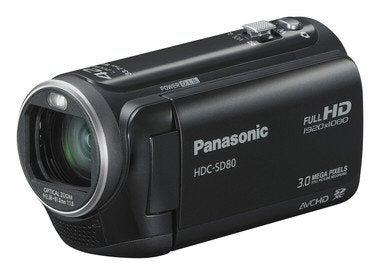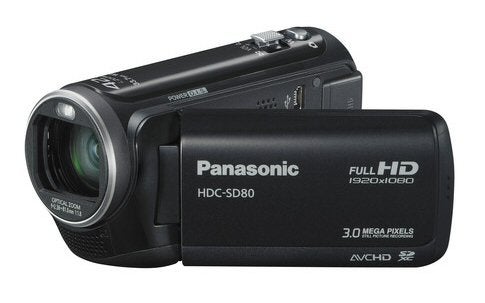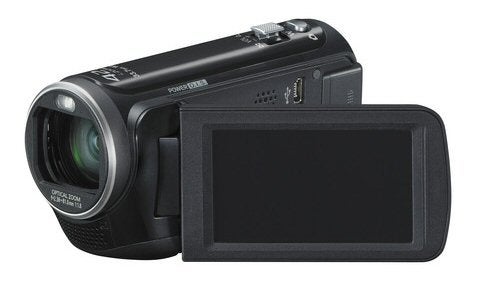Panasonic HDC-SD80 Review
Panasonic HDC-SD80
A budget model that still offers some user controls.

Verdict
Pros
- Decent low-light performance
- Touch-screen LCD
- Manual features
Cons
- Relatively expensive for a budget model
- No accessory shoe
- No mic input
Key Specifications
- Review Price: £307.00
- 1/5.8in CMOS sensor with 1.5Mpixels
- Full HD shooting
- SDXC-compatible SD memory slot
- 37x optical zoom; 42x Intelligent zoom
- Independent iris and shutter controls
The HDC-SD80 is not the SD90 without as many bells and whistles. It uses a smaller 1/5.8in CMOS with just 1.5Mpixels. So although it records Full HD, there’s a little interpolation involved to make up the full 2.07Mpixels of this format. Even more interpolation is involved in the maximum still image resolution of 2,304 x 1,296, which the SD80 can even manage at the same time as shooting video.
The small sensor allows the SD80 to offer a hefty 37x optical zoom, and you can turn on the Intelligent Zoom function to boost this a little to 42x. However, where most systems use surplus sensor pixels for this kind of technology, the SD80 doesn’t have any, so this will reduce resolution, just not as much as a traditional digital zoom. Strangely, although the built-in lens cover is not fully automatic, it does pop open when you power the camcorder on. But you need to close it manually after you’ve turned the unit off.
Despite being a lower end model, the SD80 still offers Panasonic’s latest Hybrid OIS. This blends electronic and optical systems to provide even more powerful stabilisation, tuned to smooth out the low-frequency vibrations caused by shooting whilst walking, as well as the higher-frequency jerkiness associated with handheld work whilst zoomed in. There are two modes available, although the second of these is aimed at still image mode.
The SD80 offers four HD recording formats, all of which operate at 1,920 x 1,080 pixels and use AVCHD encoding. Data rates range from 5 to 17Mbits/sec, although the top 24Mbits/sec afforded by AVCHD isn’t available. Like other recent Panasonic models, you also get an iFrame format option, which records H.264 at 960 x 540, a quarter of Full HD, and is included for Mac compatibility. Footage is captured to SD memory cards, with a single SDXC-compatible slot available and Class 4 performance required, so cards up to 64GB can be used. At the top HA video quality setting, a 64GB card will be enough for 8.5 hours of footage.

Despite the budget orientation, the SD80 still incorporates a touchscreen. This opens up a world of touch-operated functions. These include AF/AE tracking, where you specify a point to use as a reference for focus and exposure, which is then tracked across the screen as it moves. The touch zoom provides another way to operate the telephoto. Gliding your finger towards the centre of the frame zooms in, and gliding it away zooms out. Touch Shutter will be familiar to users of some mobile phones. Simply touch the screen to select a reference point for focus, after which a photo is taken automatically. Finally, the optical image stabiliser lock enables even more powerful smoothing when shooting whilst zoomed in.
The touch screen is used for almost all functions, with just a switch on the rear to cycle between camcorder, photo and playback modes, plus buttons under the LCD to toggle image stabilisation on and off, and select manual or auto settings. In automatic mode, the SD80 uses Panasonic’s increasingly sophisticated iA system. This detects conditions and sets the scene mode accordingly, for example invoking Portrait when faces are picked up, Scenery when there’s an expanse of bright sky, or Low Light in poor illumination. If you do want a little more control, without going fully manual, the usual array of scene modes is also available, including favourites like Sport and Portrait. There are 11 options here, making this a fairly comprehensive selection.
However, there is also a manual mode, which offers the same level of configurability we’ve come to expect from Panasonic camcorders. You can focus manually using a slider, which is pretty fiddly, but at least there’s an assist function to help you, which fringes areas in focus with blue. You can adjust the shutter from 1/8,000th to 1/50th (or 1/25th in slow shutter mode), iris from F16 to F1.8, and then add 18dB of video gain on the top of a fully open aperture. Best of all, you can adjust shutter and iris independently.
White balance options include presets for sunny and cloudy outdoor days, plus tungsten and fluorescent indoor situations, alongside auto and manual. You even get picture adjustments, including sharpness, colour, exposure and white balance bias. There’s a soft skin setting available, too. Not surprisingly, though, the SD80 doesn’t offer any enthusiast features, such as microphone inputs or an accessory shoe; for this, you will need to step up to the SD90. This model is aimed at the mainstream user exclusively. But you do get manual control over audio levels.
Panasonic’s SD90 offers just about the best image quality in its price range, but the SD80 has a considerably smaller sensor. Nevertheless, although its footage lacks a little of the detail of its more expensive sibling, colour fidelity is similarly good in decent lighting. The biggest revelation is low light performance, which we had expected to be noticeably inferior to the SD90’s due to the tiny CMOS. There is greater sign of grain, but the picture remains brighter than most camcorders with sensors this size can achieve. Overall, the SD80 will pick up a decent picture in most everyday conditions, belying its £300 price.
Verdict
Panasonic’s HDC-SD80 is a good budget camcorder, offering decent image quality and a healthy array of manual settings if you do find you want to take a little more control of your shooting. However, if you do just want a cheap point-and-shoot camcorder capable of good image quality, JVC’s Everio GZ-HM445 lacks the range of manual controls, but shoots comparably good video and also offers a touch LCD for quite a bit less outlay.
Trusted Score
Score in detail
-
Design 8
-
Image Quality 8
-
Features 7
-
Value 8
-
Perfomance 8
Image Processor
| Image Sensor | 1/5.8in CMOS with 1.5MPixels |
| Image Sensor Quantity | 1 |
Lens Features
| Optical Zoom (Times) | 42x |
| Digital Zoom (Times) | 2000x |
Video Recording
| Recording Media | SD card |
| Video Capture Format | AVCHD |
| Max Video Res | 1920 x 1080 |
| Minimum Lux Rating (Lux) | 7.0 (1/25 Low Light scene mode) / 1 (Color Night View)lx |
| Image Stabilisation | Hybrid OIS |
General Features
| LCD Screen Size (Inch) | 2.7in |
| On-board Storage (Gigabyte) | 0GB |
| On-board Microphone | 2ch Stereo, Zoom Microphone |
A/V ports
| HDMI | Yes (mini) |
| USB 2.0 | Yes |
| Audio / Video Out | Yes |
| Audio / Video In | No |
| External Microphone | No |
Physical Specifications
| Weight (Gram) | 0.192g |


